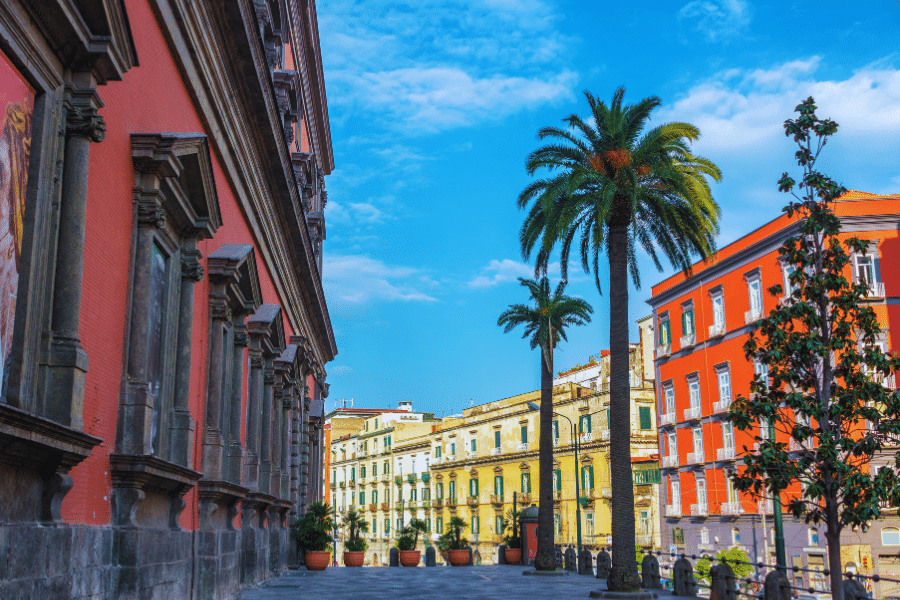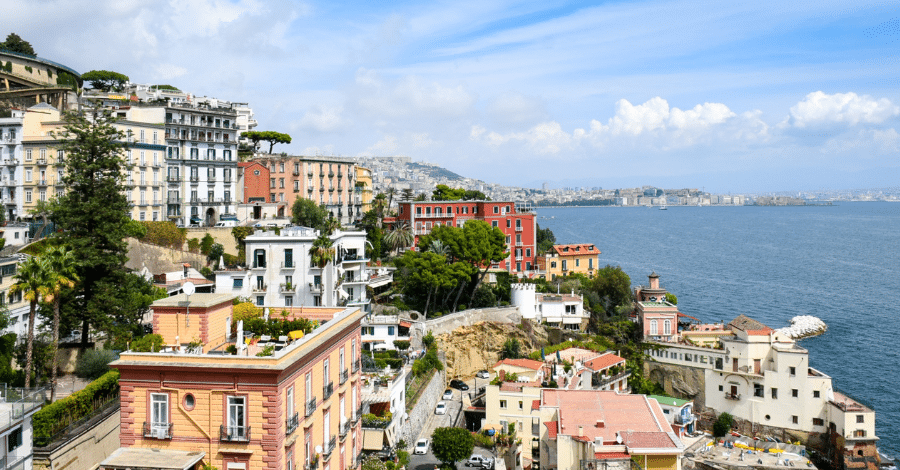If moving to Naples is in your plans in the near future, you’re in for the experience of a lifetime. Living in Naples is the essence of Italian living in every way: the people, the lifestyle, the vibe and the food are sure to activate all your senses and enrich your life for the better.
Naples, or Napoli in Italian, is a vibrant large city in southern Italy’s Campania region, offering a unique living experience for families, young professionals, and retirees. Known as the birthplace of pizza, Naples is famous for its rich culinary traditions, passionate locals, and stunning coastal location.

The city is situated on the northern edge of the Bay of Naples, about 225 kilometers (140 miles) southeast of Rome and 150 kilometers (93 miles) southeast of the Eternal City.
Living in Naples Italy
With a population of around 3 million in its metropolitan area, Naples is Italy’s third-largest city. It offers a bustling urban environment with a distinctly southern Italian character. The city center, a UNESCO World Heritage site, is a maze of narrow streets, grand palaces, and ancient churches, providing a stark contrast to the more modern suburbs. Naples has a reputation for being chaotic and gritty, but it’s also known for its warmth, creativity, and zest for life.
Naples is very much an Italian city, with fewer English speakers compared to more touristy destinations like Rome or Florence. While the historical center attracts many visitors, much of the city retains an authentic feel where traditional Neapolitan culture thrives. Learning Italian is advisable for daily life, although younger people and those in the tourism industry often speak some English.
The city enjoys a Mediterranean Italian climate with mild, wet winters and hot, dry summers. Average temperatures range from 8°C (46°F) in January to 24°C (75°F) in August. Naples receives about 1,000 mm (39 inches) of rainfall annually, mainly in the winter months. Snow is rare, and the city boasts around 250 days of sunshine per year.
Naples offers several beautiful parks and green spaces, including the sprawling Capodimonte Park surrounding the royal palace. The city’s position on the bay provides stunning sea views, and nearby attractions include the Amalfi Coast, the islands of Capri and Ischia, and Mount Vesuvius.
The local economy is diverse, with strong sectors in tourism, services, and industry. Major employers include the University of Naples Federico II, the Port of Naples, and various manufacturing companies. The city also has a growing tech startup scene.
Pros of moving to Naples include its rich cultural heritage, world-renowned cuisine, relatively low cost of living compared to northern Italian cities, and proximity to beautiful coastal areas. The city’s public transportation system, including an extensive metro network, makes getting around relatively easy.
Cons include higher unemployment rates compared to northern Italy, issues with waste management in some areas, and a reputation for petty crime (though this has improved in recent years). The chaotic traffic and the city’s intensity might also be challenging for those used to a quieter pace of life.
Housing in Naples
Rental options in Naples vary widely, from apartments in historic buildings to modern flats in residential areas. According to recent data from My Dolce Casa, the average rent in Naples for a two-bedroom apartment costs around €1,100 per month or $1,200 in US dollars. In comparison, the national average rent is about the same, while in Rome it’s around €1,250 per month and Milano €1,750.

For those looking to buy property in Naples Italy, the average price per square meter according to My Dolce Casa’s most recent Real Estate Report is approximately €2,700, which is slightly below the national average. A two-bedroom apartment would cost around €200,000, while a four-bedroom house might be priced at about €540,000.
In US dollars, these figures translate to approximately $225,000 for an apartment and $560,000 for a house. The national average price per square foot is about $280, lower than Milan, Florence, Rome or Venice.
The historic center (Centro Storico) is popular among expats for its charm and central location, but properties here can be older and more expensive. Vomero is an upscale residential area known for its panoramic views and good schools, making it attractive for families. Chiaia, near the seafront, offers a mix of elegant residential buildings and vibrant nightlife.
Architectural styles in Naples range from medieval and baroque in the historic center to Art Nouveau in Vomero and modern constructions in newer areas. Many buildings in the centro storico date back to the 16th and 17th centuries, while areas like Chiaia feature 19th-century architecture.
Shopping in Naples
Naples offers diverse shopping experiences, from high-end boutiques to local markets. The Galleria Umberto I, a historic shopping gallery, houses numerous shops and cafes under its stunning glass dome. For luxury brands, Via dei Mille and Via Filangieri in the Chiaia district are the go-to destinations.
The Vomero district is home to several shopping centers, including the Centro Commerciale Vomero, which offers a mix of Italian and international brands. For a more traditional experience, the Mercato di Porta Nolana near the central station is famous for its fresh seafood and local produce.
Common grocery store chains in Naples include Conad, Carrefour, and Decò. For a true Neapolitan shopping experience, visit the bustling street market on Via Pignasecca, where you can find everything from fresh produce to household goods.

Transportation in Naples
Naples has an extensive public transportation system, including buses, trams, funicular railways, and a metro. The Unico Campania app is useful for route planning and ticket purchases. The metro system, with its artistically designed stations, is a highlight of the city’s public transport.
The main railway station, Napoli Centrale, offers connections to major Italian cities. High-speed trains reach Rome in just over an hour. Naples is also well-connected by sea, with ferries departing from the port to nearby islands and coastal towns.
For international travel, Naples International Airport is located about 6 kilometers (3.7 miles) northeast of the city center. It offers flights to major European cities and some intercontinental destinations.
Healthcare in Naples
Naples is home to several high-quality hospitals. The largest is the Ospedale Antonio Cardarelli, a public hospital known for its emergency care and specialized departments. It’s located in the northern part of the city, about a 15-minute drive from the center.
For pediatric care, the Santobono-Pausilipon Hospital is the main children’s hospital in southern Italy, located in the Vomero district.
Check out this list of the best hospitals in Italy for more medical specialties.
Education in Naples
International schools in Naples include the Naples International School, which offers an English-language curriculum following the International Baccalaureate program. It’s located in the Vomero district.
Notable public schools include the Liceo Classico Vittorio Emanuele II, one of the oldest high schools in Italy, and the Istituto Tecnico Industriale Alessandro Volta, which specializes in technical education.
The University of Naples Federico II, founded in 1224, is one of the oldest universities in the world and offers a wide range of programs. The city is also home to several other higher education institutions, contributing to a lively student atmosphere.
Dining and entertainment in Naples
Naples hosts numerous cultural events throughout the year, including the Napoli Teatro Festival Italia in June and July, and the Napoli Film Festival in September.

The city boasts world-class museums such as the National Archaeological Museum, housing artifacts from Pompeii and Herculaneum, and the Capodimonte Museum, showcasing works by Caravaggio, Titian, and other masters.
For performing arts, the Teatro di San Carlo is the oldest continuously active opera house in Europe. The PAN | Palazzo delle Arti Napoli hosts contemporary art exhibitions.
Families can enjoy the Naples Zoo, located within the Astroni Nature Reserve. The city’s position on the bay also means beaches are easily accessible, with popular spots like Gaiola and Miseno a short trip away.
Neapolitan cuisine is world-renowned, with pizza being the star attraction. Other local specialties include pasta alla Genovese (pasta with slow-cooked onion sauce), sfogliatella (a shell-shaped pastry), and mozzarella di bufala. The city is also famous for its coffee culture.

The Campania region produces excellent wines, including the white Greco di Tufo and Fiano di Avellino, both made from local grape varieties. For red wine, try Taurasi, made primarily from the Aglianico grape, known for its full body and aging potential. The sweet Lacryma Christi del Vesuvio, produced on the slopes of Mount Vesuvius, is another local specialty worth trying.

